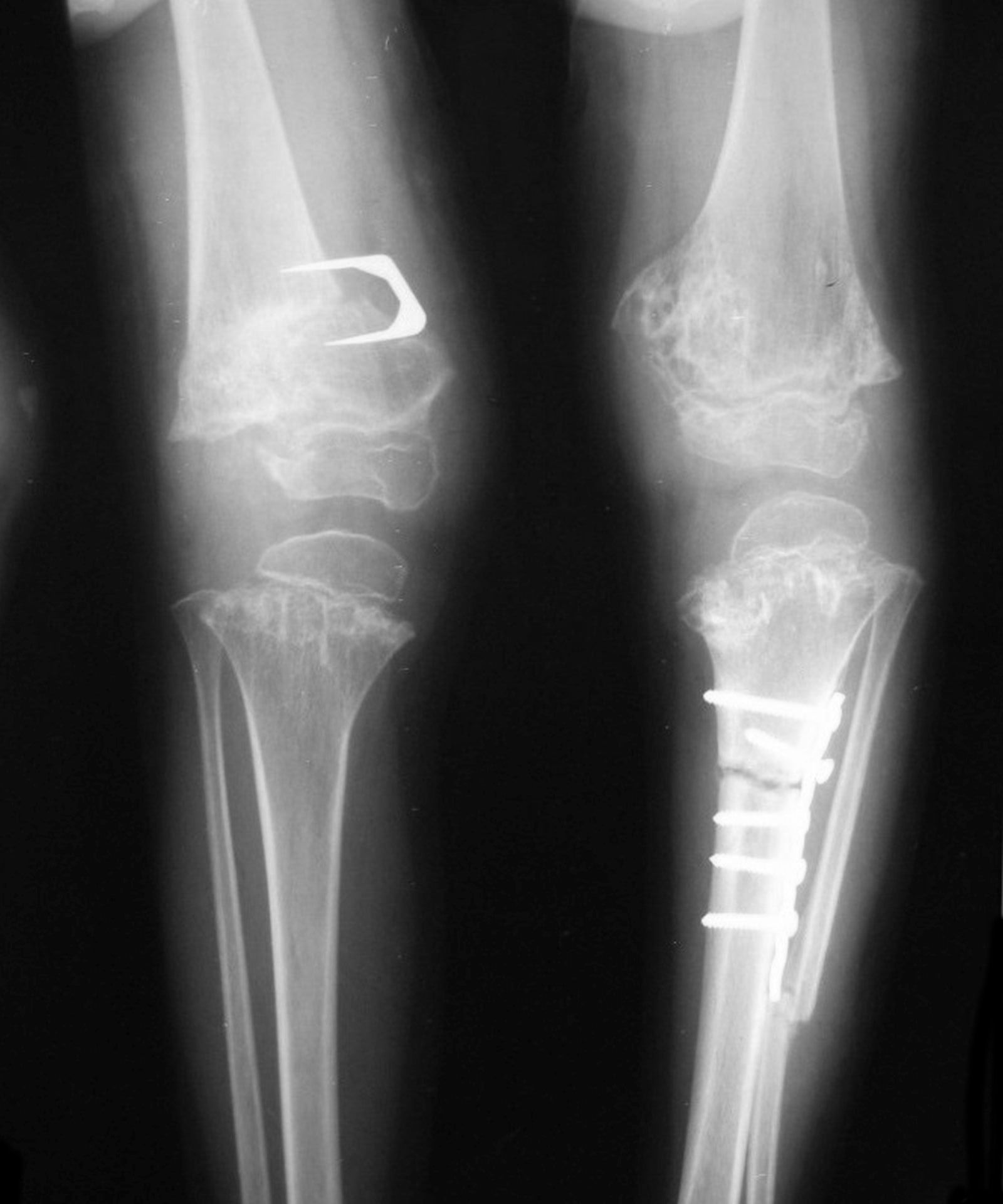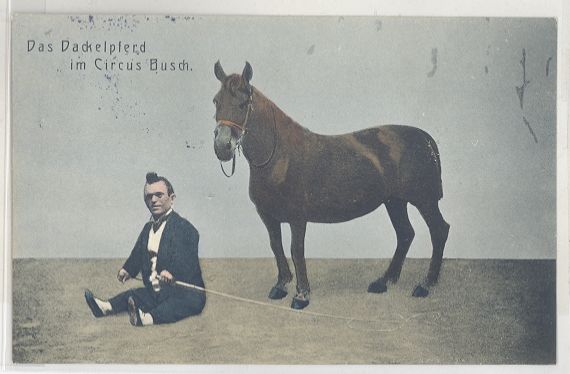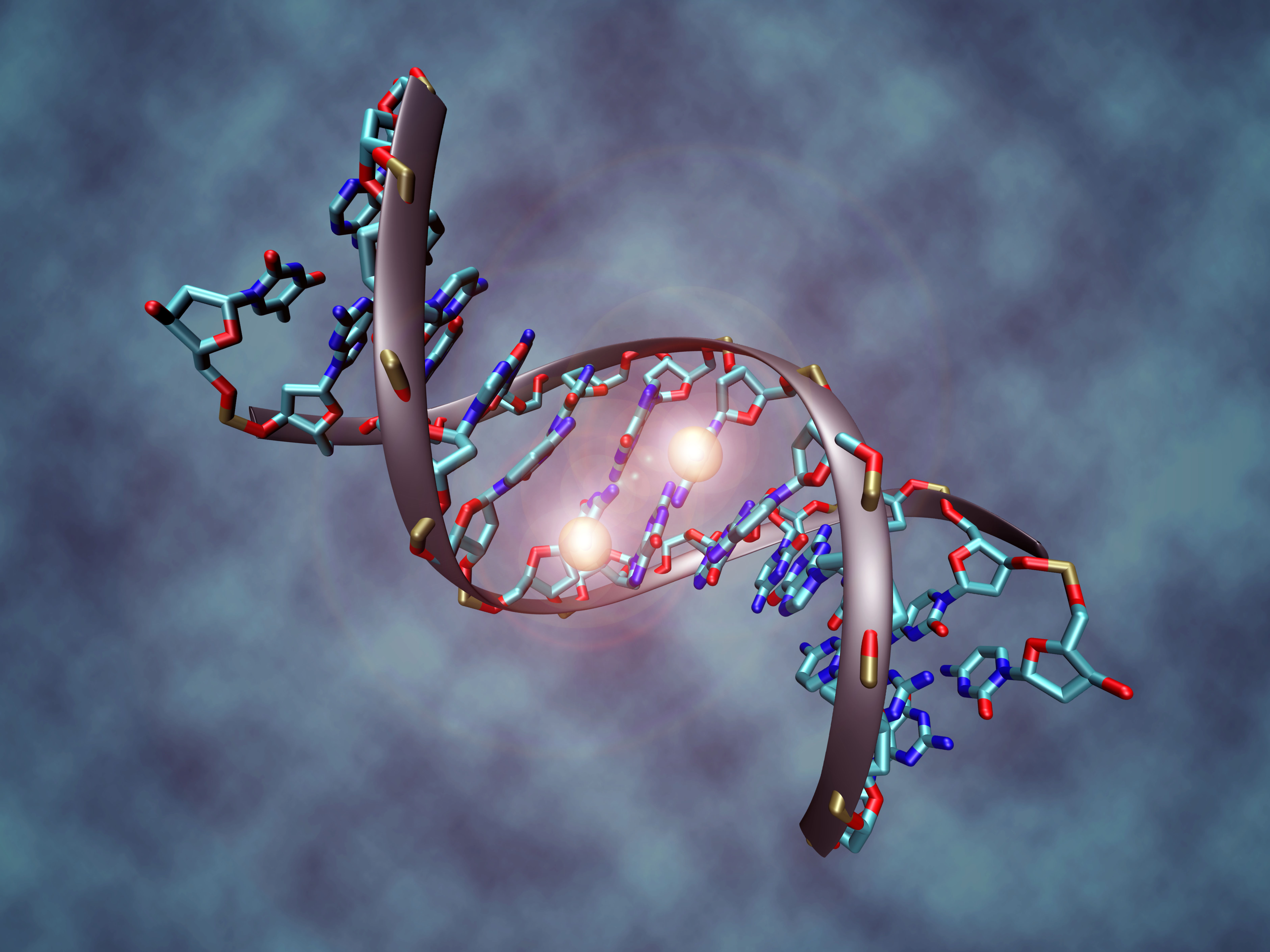|
Achondroplasia
Achondroplasia is a genetic disorder with an autosomal dominant pattern of inheritance whose primary feature is dwarfism. In those with the condition, the arms and legs are short, while the torso is typically of normal length. Those affected have an average adult height of for males and for females. Other features can include an enlarged head and prominent forehead. Complications can include sleep apnea or recurrent ear infections. Achondroplasia includes short-limb skeletal dysplasia with severe combined immunodeficiency. Achondroplasia is caused by a mutation in the fibroblast growth factor receptor 3 (''FGFR3'') gene that results in its protein being overactive. Achondroplasia results in impaired endochondral bone growth (bone growth within cartilage). The disorder has an autosomal dominant mode of inheritance, meaning only one mutated copy of the gene is required for the condition to occur. About 80% of cases occur in children of parents of average stature and result f ... [...More Info...] [...Related Items...] OR: [Wikipedia] [Google] [Baidu] |
Pseudoachondroplasia
Pseudoachondroplasia is an inherited disorder of bone growth. It is a genetic autosomal dominant disorder. It is generally not discovered until 2–3 years of age, since growth is normal at first. Pseudoachondroplasia is usually first detected by a drop of linear growth in contrast to peers, a waddling gait or arising lower limb deformities. Pseudoachondroplasia (also known as PSACH, pseudoachondroplastic dysplasia, and pseudoachondroplastic spondyloepiphyseal dysplasia syndrome) is an osteochondrodysplasia that results in mild to severely short stature due to the inhibition of skeletal growth primarily in the limbs. Though similarities in nomenclature may cause confusion, pseudoachondroplasia should not be confused with achondroplasia, which is a clinically and genetically distinct skeletal dysplasia. Pseudoachondroplasia is caused by a heterozygous mutation in the gene encoding cartilage oligomeric matrix protein (COMP). Mutation in the COMP gene can also cause multiple epiph ... [...More Info...] [...Related Items...] OR: [Wikipedia] [Google] [Baidu] |
Dwarfism
Dwarfism is a condition wherein an organism is exceptionally small, and mostly occurs in the animal kingdom. In humans, it is sometimes defined as an adult height of less than , regardless of sex; the average adult height among people with dwarfism is , although some individuals with dwarfism are slightly taller. ''Disproportionate dwarfism'' is characterized by either short limbs or a short torso. In cases of ''proportionate dwarfism'', both the limbs and torso are unusually small. Intelligence is usually normal, and most have a nearly normal life expectancy. People with dwarfism can usually bear children, though there are additional risks to the mother and child dependent upon the underlying condition. The most common and recognisable form of dwarfism in humans (comprising 70% of cases) is achondroplasia, a genetic disorder whereby the limbs are diminutive. Growth hormone deficiency is responsible for most other cases. Treatment depends on the underlying cause. Those w ... [...More Info...] [...Related Items...] OR: [Wikipedia] [Google] [Baidu] |
Fibroblast Growth Factor Receptor 3
Fibroblast growth factor receptor 3 is a protein that in humans is encoded by the ''FGFR3'' gene. FGFR3 has also been designated as CD333 (cluster of differentiation 333). The gene, which is located on chromosome 4, location q16.3, is expressed in tissues such as the cartilage, brain, intestine, and kidneys. The FGFR3 gene produces various forms of the FGFR3 protein; the location varies depending on the isoform of the FGFR3 protein. Since the different forms are found within different tissues the protein is responsible for multiple growth factor interactions. Gain of function mutations in FGFR3 inhibits chondrocyte proliferation and underlies achondroplasia and hypochondroplasia. Function The protein encoded by this gene is a member of the fibroblast growth factor receptor family, where amino acid sequence is highly conserved between members and throughout evolution. FGFR family members differ from one another in their ligand affinities and tissue distribution. A full-length ... [...More Info...] [...Related Items...] OR: [Wikipedia] [Google] [Baidu] |
FGFR3
Fibroblast growth factor receptor 3 is a protein that in humans is encoded by the ''FGFR3'' gene. FGFR3 has also been designated as CD333 (cluster of differentiation 333). The gene, which is located on chromosome 4, location q16.3, is expressed in tissues such as the cartilage, brain, intestine, and kidneys. The FGFR3 gene produces various forms of the FGFR3 protein; the location varies depending on the isoform of the FGFR3 protein. Since the different forms are found within different tissues the protein is responsible for multiple growth factor interactions. Gain of function mutations in FGFR3 inhibits chondrocyte proliferation and underlies achondroplasia and hypochondroplasia. Function The protein encoded by this gene is a member of the fibroblast growth factor receptor family, where amino acid sequence is highly conserved between members and throughout evolution. FGFR family members differ from one another in their ligand affinities and tissue distribution. A full-length ... [...More Info...] [...Related Items...] OR: [Wikipedia] [Google] [Baidu] |
Paternal Age
The paternal age effect is the statistical relationship between the father's age at conception and biological effects on the child. Such effects can relate to birthweight, congenital disorders, life expectancy and psychological outcomes. A 2017 review found that while severe health effects are associated with higher paternal age, the total increase in problems caused by paternal age is low. While paternal age has increased since 1960–1970, this is not seen as a major public health concern. The genetic quality of sperm, as well as its volume and motility, all may decrease with age, leading the population geneticist James F. Crow to claim that the "greatest mutational health hazard to the human genome is fertile older males". The paternal age effect was first proposed implicitly by physician Wilhelm Weinberg in 1912 and explicitly by psychiatrist Lionel Penrose in 1955. DNA-based research started more recently, in 1998, in the context of paternity testing. Health effects Eviden ... [...More Info...] [...Related Items...] OR: [Wikipedia] [Google] [Baidu] |
Rhizomelia
Rhizomelia refers to either a disproportion of the length of the proximal limb, such as the shortened limbs of achondroplasia, or some other disorder of the hip or shoulder. According to Stedman's medical dictionary "rhizomelic" means "relating to hip or shoulder joints", while "micromelic" means "having disproportionately short or small limbs". Genetic skeletal dysplasias or Osteochondrodysplasia frequently lead to short stature, occasionally termed dwarfism, which is classified into proportionate and disproportionate short stature. Disproportionate short stature is further classified short-limb short stature and short-trunk short stature. In turn, short-limb short stature is classified into a) Rhizomelic, b) mesomelic and c) acromelic short stature. Rhizomelic short stature refers to skeletal dysplasias where the main shortening is due to involvement of the proximal limb segments i.e. femora and humeri. Typical examples of Rhizomelic short stature are achondroplasia and pseudoacho ... [...More Info...] [...Related Items...] OR: [Wikipedia] [Google] [Baidu] |
Genetic Disorder
A genetic disorder is a health problem caused by one or more abnormalities in the genome. It can be caused by a mutation in a single gene (monogenic) or multiple genes (polygenic) or by a chromosomal abnormality. Although polygenic disorders are the most common, the term is mostly used when discussing disorders with a single genetic cause, either in a gene or chromosome. The mutation responsible can occur spontaneously before embryonic development (a ''de novo'' mutation), or it can be Heredity, inherited from two parents who are carriers of a faulty gene (autosomal recessive inheritance) or from a parent with the disorder (autosomal dominant inheritance). When the genetic disorder is inherited from one or both parents, it is also classified as a hereditary disease. Some disorders are caused by a mutation on the X chromosome and have X-linked inheritance. Very few disorders are inherited on the Y linkage, Y chromosome or Mitochondrial disease#Causes, mitochondrial DNA (due to t ... [...More Info...] [...Related Items...] OR: [Wikipedia] [Google] [Baidu] |
Jason Acuña
Jason Shannon Acuña (born May 16, 1973), better known by his stage name Wee Man, is an American stunt performer, television personality, professional skateboarder, and actor. He is one of the stars of '' Jackass'' and the host of Fox Sports Net's skateboarding show ''54321''. Acuña has achondroplasia, a form of dwarfism. Life and career Born in Pisa, Italy, Acuña grew up in Torrance, California, and attended North High School. He is of Mexican and German descent. He was the subscription manager for the skateboard magazine '' Big Brother''. His association with that magazine led him to become involved with the '' Jackass'' television series in 2000. Acuña's ''Jackass'' antics include skating as an Oompa-Loompa, kicking himself in the head, dressing as a king while rolling Johnny Knoxville down a staircase in a red carpet, and doing deep-knee bends while holding basketball star Shaquille O'Neal on his back. A recurring gag involves Preston Lacy asking someone to help him wit ... [...More Info...] [...Related Items...] OR: [Wikipedia] [Google] [Baidu] |
Spinal Stenosis
Spinal stenosis is an abnormal narrowing of the spinal canal or neural foramen that results in pressure on the spinal cord or nerve roots. Symptoms may include pain, numbness, or weakness in the arms or legs. Symptoms are typically gradual in onset and improve with leaning forward. Severe symptoms may include loss of bladder control, loss of bowel control, or sexual dysfunction. Causes may include osteoarthritis, rheumatoid arthritis, spinal tumors, trauma, Paget's disease of the bone, scoliosis, spondylolisthesis, and the genetic condition achondroplasia. It can be classified by the part of the spine affected into cervical, thoracic, and lumbar stenosis. Lumbar stenosis is the most common, followed by cervical stenosis. Diagnosis is generally based on symptoms and medical imaging. Treatment may involve medications, bracing, or surgery. Medications may include NSAIDs, acetaminophen, or steroid injections. Stretching and strengthening exercises may also be useful. Limiting ... [...More Info...] [...Related Items...] OR: [Wikipedia] [Google] [Baidu] |
Short-limb Skeletal Dysplasia With Severe Combined Immunodeficiency
Short-limb skeletal dysplasia with severe combined immunodeficiency is an extremely rare autosomal recessive type of achondroplasia which is characterized by short stature, bowing of the long bones, and generalized metaphyseal abnormalities alongside signs of SCID such as recurrent severe infections, failure to thrive, chronic diarrhea Diarrhea, also spelled diarrhoea, is the condition of having at least three loose, liquid, or watery bowel movements each day. It often lasts for a few days and can result in dehydration due to fluid loss. Signs of dehydration often begin wi ..., and a notable absence of T and B lymphocytes. Around 11 cases have been described in medical literature. References {{reflist Cell surface receptor deficiencies Connective tissue diseases Growth disorders Rare diseases Immunodeficiency Genetic diseases and disorders Autosomal recessive disorders ... [...More Info...] [...Related Items...] OR: [Wikipedia] [Google] [Baidu] |
Thanatophoric Dysplasia
Thanatophoric dysplasia is a severe skeletal disorder characterized by a disproportionately small ribcage, extremely short limbs and folds of extra skin on the arms and legs. Symptoms and signs Infants with this condition have disproportionately short arms and legs with extra folds of skin. Other signs of the disorder include a narrow chest, small ribs, underdeveloped lungs, and an enlarged head with a large forehead and prominent, wide-spaced eyes. Thanatophoric dysplasia is a lethal skeletal dysplasia divided into two subtypes. Type I is characterized by extreme rhizomelia, bowed long bones, narrow thorax, a relatively large head, normal trunk length and absent cloverleaf skull. The spine shows platyspondyly, the cranium has a short base, and, frequently, the foramen magnum is decreased in size. The forehead is prominent, and hypertelorism and a saddle nose may be present. Hands and feet are normal, but fingers are short. Type II is characterized by short, straight long bones a ... [...More Info...] [...Related Items...] OR: [Wikipedia] [Google] [Baidu] |
Medical Genetics
Medical genetics is the branch tics in that human genetics is a field of scientific research that may or may not apply to medicine, while medical genetics refers to the application of genetics to medical care. For example, research on the causes and inheritance of genetic disorders would be considered within both human genetics and medical genetics, while the diagnosis, management, and counselling people with genetic disorders would be considered part of medical genetics. In contrast, the study of typically non-medical phenotypes such as the genetics of eye color would be considered part of human genetics, but not necessarily relevant to medical genetics (except in situations such as albinism). ''Genetic medicine'' is a newer term for medical genetics and incorporates areas such as gene therapy, personalized medicine, and the rapidly emerging new medical specialty, predictive medicine. Scope Medical genetics encompasses many different areas, including clinical practice of ... [...More Info...] [...Related Items...] OR: [Wikipedia] [Google] [Baidu] |





